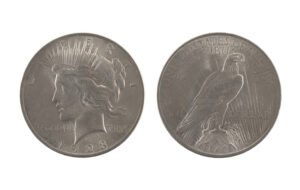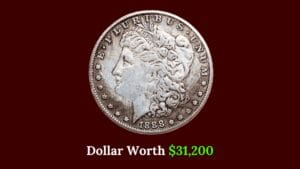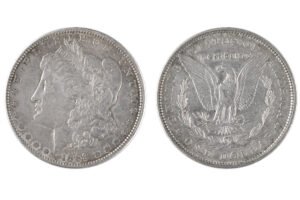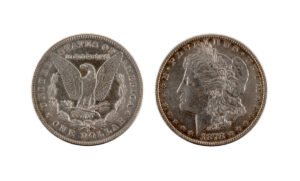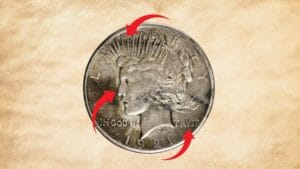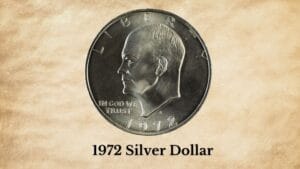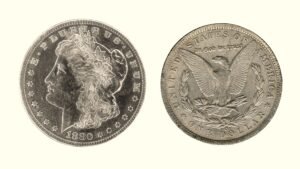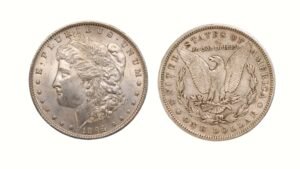Did you know an old 1886 Morgan Silver Dollar coin sold for a mind-boggling price of $780,000 in a coin auction? That’s right! This ordinary-looking dollar coin is actually a hidden gem that many coin collectors often overlook.
So, if you want to know whether your 1886 silver dollar is worth thousands of dollars, this is the guide you need. It will explain all the valuable features, like rare mint marks, VAMs, and mint errors, that can seriously boost your coin’s true value!
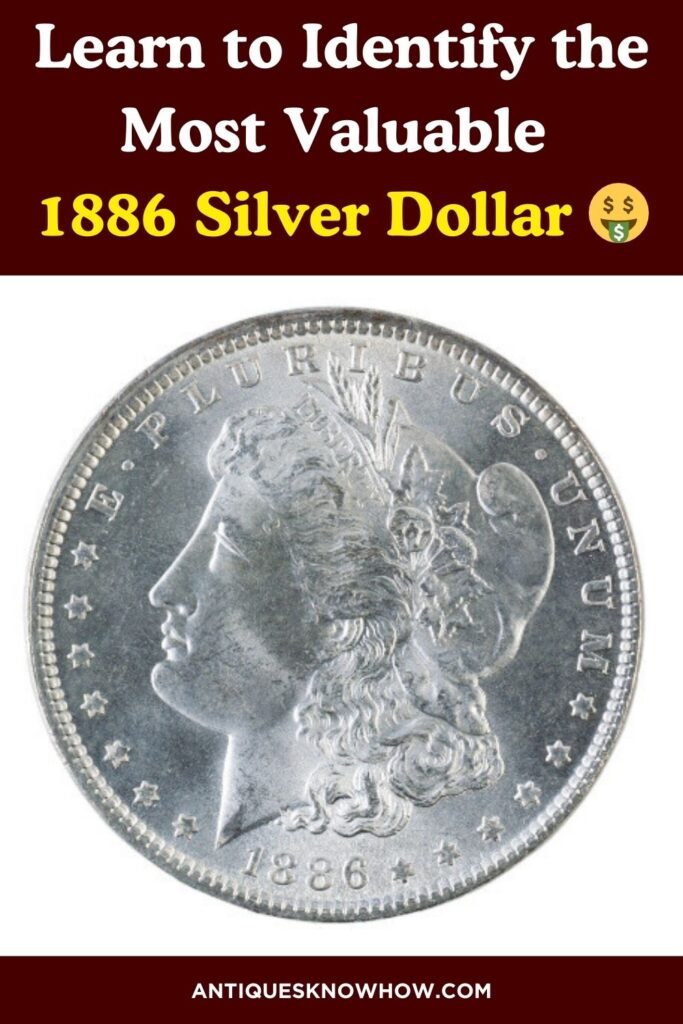
1886 Morgan Dollar History
The 1886 Morgan Dollar is a significant part of the Morgan Dollar series, named after its designer, George T. Morgan. First introduced in 1878, the series was a result of the Bland-Allison Act, which required the U.S. Treasury to purchase large quantities of silver and convert it into silver dollars.
By 1886, the Morgan Dollar had become a popular silver dollar coin among Americans. As a result, this particular year saw a substantial mintage across multiple facilities.
| 1886 Morgan Silver Dollar | Key Facts |
| Material Composition | 90% Silver, 10% Copper |
| Minting Location | Philadelphia, Carson City, New Orleans, & San Francisco |
| Year of Minting | 1886 |
| Face Value | $1.00 |
| Weight | 26.73 grams |
| Actual Silver Content | 0.7734 oz |
| Diameter | 38.1mm |
| Thickness | 2.4mm |
| Designer | George T. Morgan |
| Mint Marks | ‘CC’ – Carson City, ‘O’ – New Orleans & ‘S’ – San Francisco |
| Total Mintage | 31,423,000 coins |
Identifying 1886 Morgan Silver Dollar Design & Composition
The 1886 Morgan Dollar features a distinctive design and specific physical characteristics that make it easily identifiable among other old coins.
1886 Morgan Dollar Obverse:
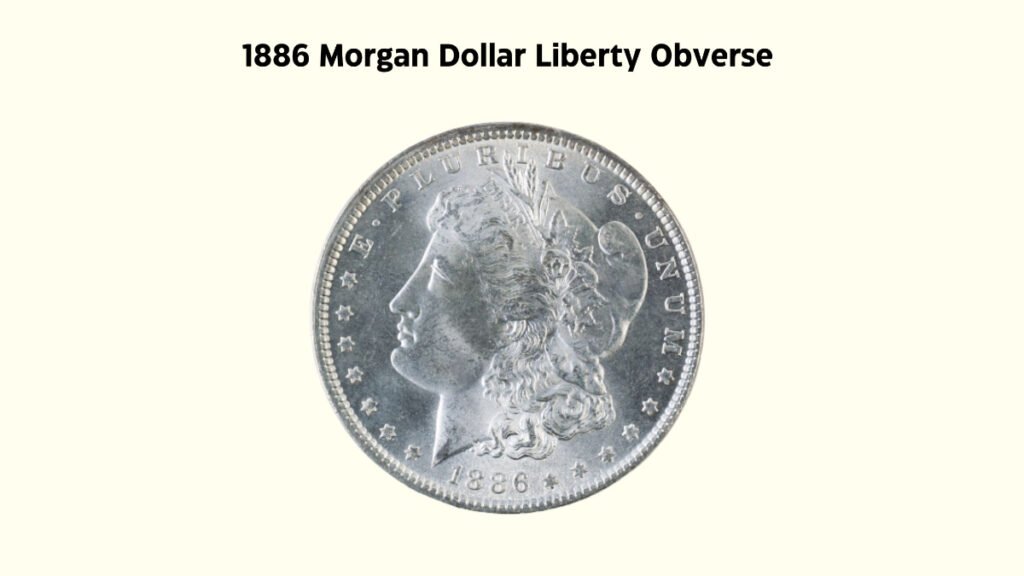
- Liberty’s head facing left, wearing a Phrygian cap adorned with wheat and cotton
- The word “LIBERTY” inscribed on a ribbon in Liberty’s hair
- The motto “E PLURIBUS UNUM” arced above Liberty’s head
- 13 stars surrounding the portrait, representing the original colonies
- The designer’s initial “M” on Liberty’s neck line
- The mint date “1886” below Liberty’s neck
1886 Morgan Dollar Reverse:

- A heraldic eagle with wings spread, clutching arrows and an olive branch
- “UNITED STATES OF AMERICA” arcing above the eagle
- “ONE DOLLAR” inscribed below the eagle
- The motto “IN GOD WE TRUST” above the eagle’s head
- A wreath encircling the lower half of the design
Coin Composition and Dimensions
The 1886 Morgan Dollar is made up of 90% silver and 10% copper, resulting in a net silver weight of 0.7734 troy ounces. This composition, referred to as “coin silver,” was typical for U.S. silver coins during that period.
As for its size and dimension, the 1886 silver dollar has a total weight of 26.73 grams. It has a diameter of 38.1 mm and a thickness of 2.4 mm, with a defined reeded edge featuring 180 reeds as a security measure to deter clipping or shaving of its valuable metal content.
How to Assess 1886 Silver Dollar Value (4 Key Factors)
On average, an 1886 Morgan Dollar in circulated condition can be worth anywhere from $25 to $100. However, uncirculated dollar coins or those with rare characteristics can fetch much higher prices, often reaching tens or hundreds of thousands.
The final market value of an 1886 Morgan Silver Dollar depends on the following key factors:
1. Coin Grading and Condition
The condition and grading of an 1886 Morgan Silver Dollar significantly influence its value. Coins are assessed based on their physical state and graded using a scale from Poor (P-1) to Perfect Uncirculated (MS-70). Higher grades (MS65 or above) generally command significantly higher prices.
For instance, an 1886 Silver dollar in MS-65 grade might be worth $100 – $200, while the same coin in MS-68 could fetch $15,000 or more.
2. Mint Marks and Mintage
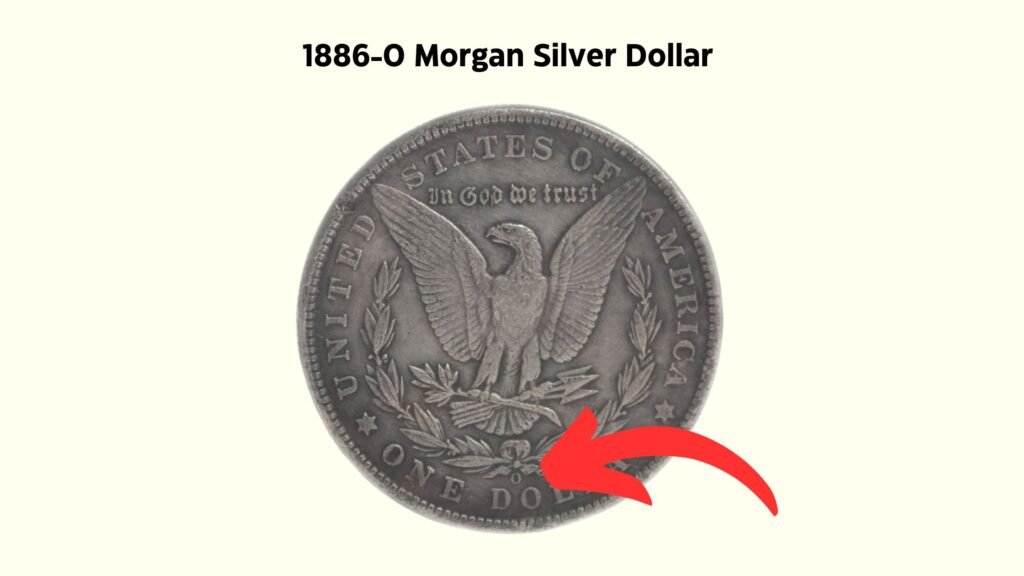
The mintage of an old coin reflects how rare and valuable it is. For the 1886 Morgan Dollar, the total mintage was 31,423,000 coins across all mints. Among these, some mints produced fewer coins, making them more valuable than others.
Here’s a breakdown of 1886 Morgan Dollar coin production across different mints:
- 1886 No Mint Mark Silver Dollar (19,963,886): The Philadelphia mint produced the largest number of 1886 Morgan Dollars, identified by no mint mark. In circulated grades, they’re worth $30-$50, while mint state specimens can fetch $60-$300 or more for higher grades.
- 1886 O Silver Dollar (10,710,000): The New Orleans-minted silver dollars have the “O” mint mark on the reverse. Circulated 1886-O silver dollars typically value between $30-$60, while uncirculated coins can range from $1,000 – $5,000. MS65 or higher grades may fetch $115,000 – $250,000, like this MS65 example that sold for a record price of $235,000 on Legend Rare Coin Auctions!
- 1886 S Silver Dollar (750,000): With the lowest mintage, the San Francisco-minted 1886 Morgan Dollars are the rarest. These coins have the “S” mint mark. The value of circulated 1886-S dollars ranges $40-$100 and low mint-grade examples range from $125-$1,000. High-mint grade examples, like MS67, can fetch up to $70,000!
I’ve curated a detailed 1886 Morgan Dollar value chart based on mint marks and grades to help you easily find your coin’s average value.
| Coin Grades | Condition Details | 1886 No Mint Mark Dollar Value | 1886 O Morgan Dollar Value | 1886 S Morgan Dollar Value |
| Poor (0) to Extremely Fine (XF45) | Significant wear, faded but visible details | $10 – $30 | $30 – $100 | $50 – $140 |
| Almost Uncirculated (AU50) to Mint State (MS60) | Slight wear on highest points, visible marks or blemishes | $30 – $60 | $100 – $1,500 | $110 – $400 |
| Mint State (MS61 – MS64) | Uncirculated with minimal wear | $70 – $200 | $1,100 – $32,000+ | $500 – $1,300 |
| Mint State (MS65 – MS66+) | Nearly flawless with very minor imperfections | $170 – $800 | $115,000 – $250,000+ | $1,500 – $13,000+ |
| Mint State (MS67 – MS67+) | Well-preserved with no major flaws | $900 – $2,000 | N/A | $10,000 – $66,000 |
| Mint State (MS68 or Above) | Nearly perfect, luster, no major marks or flaws | $4,000 – $17,500+ | N/A | N/A |
3. 1886 Morgan Dollar Proof Like Coins
The 1886 Morgan Dollars are also graded as “Proof Like,” distinguished by their unique mirror-like surface and frosted design characteristics.
Proof-like (PL) 1886 Morgan Dollars
These regular business strike coins exhibit a reflective, mirror-like finish similar to true-proof coins. As of now, there are around 1,251 Proof-like examples from all mints recorded by PCGS. Among these, New Orleans and San Francisco-minted PL 1886 Morgan Dollars are worth the most.

Low mint grade PL 1886 Morgan Dollars are worth around $500 to $5,000, with highest-grade examples reaching up to $25,000 or more, like this MS64 1886-O $1 coin that sold for $26,400 on Heritage Auctions!
Deep Mirror Proof-like (DMPL) 1886 Morgan Dollars
Deep Mirror Proof-like 1886 silver dollars feature more pronounced mirror-like surfaces. There are about 1,005 DMPL examples of the 1886 Morgan Dollar noted by PCGS, with values ranging from $1,000 to several thousand dollars depending on the grade.
The 1886-O DMPL Morgan Dollars are the most valuable, with the highest value reaching a whopping $780,000 for an MS67 example at Stack’s Bowers! Low mint-grade examples (MS61 to MS66) are worth $1,000 to $57,000 or more!
Use the following price chart to find your 1886 Proof-like silver dollar coin!
| Coin Condition | 1886 No Mint Mark Dollar | 1886-O Silver Dollar | 1886-S Silver Dollar |
| MS55 – MS58+ | N/A | PL: $500 – $850 DMPL: | PL: $200 – $350 |
| MS60 – MS62+ | PL: $60 – $130 DMPL: $90 – $150 | PL: $1,500 – $7,000 DMPL: $100 – $250 | PL: $300 – $500 DMPL: $270 – $1,700 |
| MS63 – MS64+ | PL: $150 – $300 DMPL: $150 – $500 | PL: $10,000 – $20,000 DMPL: $30,000 – $60,000 | PL: $500 – $2,500+ DMPL: $1,500 – $12,500 |
| MS65 – MS65+ | PL: $250 – $500+ DMPL: $500 – $1,650 | N/A | PL: $2,500 – $7,000 DMPL: $8,000 – $25,000 |
| MS66 – MS66+ | PL: $900 – $2,500 DMPL: $2,500 – $10,000 | N/A | PL: $8,000 – $16,000+ DMPL: $30,000+ |
| MS67 – MS67+ | PL: $3,000 – $7,500 DMPL: $5,500 – $15,000 | PL: N/A DMPL: $780,000 | N/A |
| MS68 – MS68+ | N/A | N/A | N/A |
4. 1886 Morgan Dollar Errors & VAMs
1886 Morgan Dollar with VAM (Van Allen and A. George Mallis) designations can be rare and highly valuable. Here are some of the valuable 1886 Silver Dollar VAMs to look for:
1. Double Date
This variety features a noticeable doubling of the date “1886” on the obverse. The doubling can be seen clearly, making it a very expensive VAM. The values of common mint grade examples, like MS64, can go up from $4,000 to $6,000, like this coin that sold for $6,325 on Heritage Auctions!
2. 3+2 Reverse Clash
This error happens when the obverse and reverse dies sometimes come together without a planchet (blank coin) between them. This causes the designs from each die to clash and leave impressions on the other die. You can spot it with the clash marks on the reverse.
An 1886 Silver Dollar with 3+2 Clashed Reverse can sell for up to $900 to $1,000 in high grades, like MS67 or above. Low mint state coins are worth $70 to $500.
3. Line In 6
You can spot this VAM by a small line on the top of the “0” part of the digit “6” in “1886.” This anomaly can add $20 – $50 to the coin’s average value. High-grade examples, like MS67 or higher, can be worth $500 – $2,000 or more.
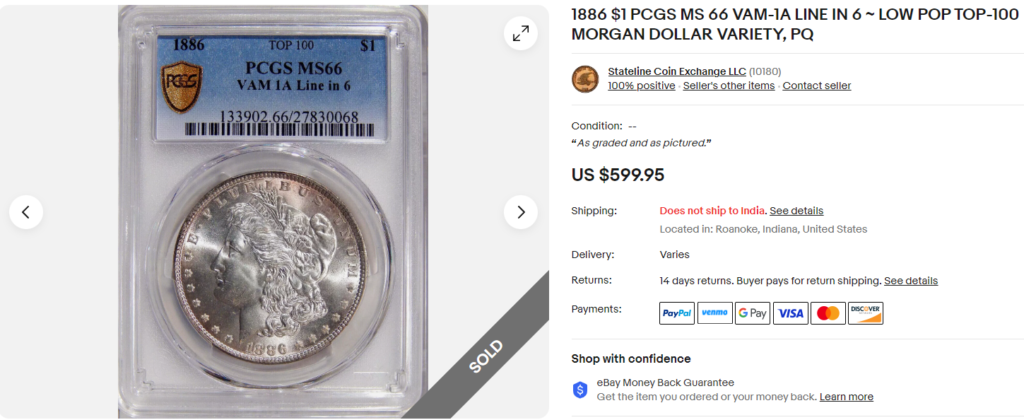
4. Line in M
This variety has a short line going through the letter “M” on Liberty’s neck line. The value of this 1886 Dollar VAM ranges from $50 to $400 in mint state.
5. Doubled Arrows
You can spot this VAM by the doubling in the feathers and pointers of the arrows on your 1886 silver dollar’s reverse. MS65 examples of this VAM coin can fetch $100 – $250.
Apart from these VAMs, the following mint errors can also boost your 1886 Morgan Dollar’s coin value:
1. Coin Struck 6 Times with Close Overlap
This rare coin is a result of an 1886 Morgan Dollar being struck six times, resulting in slightly overlapping designs. You can identify this error coin by the messy denticles around the edge, the thick outlines of the designs, and the lettering on both sides. An MS64 example of this error coin sold for almost $4,000 on Heritage Auctions in 2017!
2. Rotated Reverse Die
The 1886 Morgan Dollar Rotated Reverse Die is a variety where the reverse die was rotated out of its normal alignment when the coin was struck. This results in the reverse design being rotated clockwise or counter-clockwise by 30 to 180 degrees relative to the obverse.
Examples with a subtle 30-45 degree tilt can fetch $200 to $400, while those with a major tilt, like 90 to 180 degrees off, are rarer and more valuable.
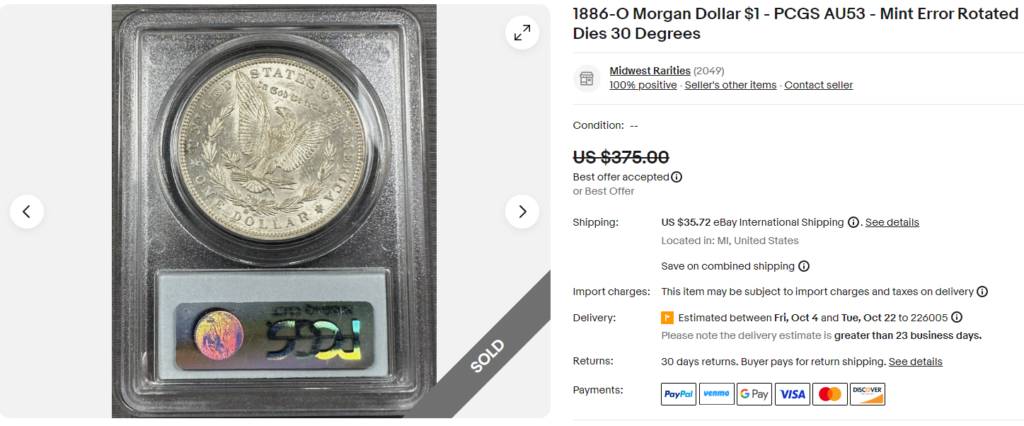
3. Partial collar strike
This 1886 Morgan Dollar error happens when the collar couldn’t confine the planchet in the die during the striking process, resulting in a coin with a beveled edge or a smooth surface. Depending on the coin’s condition, the value of this error ranges from $100 to $300.
5 Steps to Spot Real and Fake 1886 Morgan Dollars
- Check the Weight: Weight your 1886-dollar coin precisely. Authentic 1886 Morgan Dollars should match the ideal weight of
26.73 grams, failing which means it’s fake. - Examine the Reeding: Count the reeds on the edge. An authentic 1886 Morgan should have 180 reeds. Fake coins may have an incorrect number of reeds or forged uneven reeding.
- Verify the Dimensions: Measure your 1886 silver dollar coin’s diameter and thickness. Significant differences from the ideal specifications may indicate a counterfeit.
- Verify the Mint Mark: Ensure the date and mint mark (if present) are correctly styled and positioned. The Philadelphia-minted coins have no mint marks, while the San Francisco and New Orleans ones have the mint marks on reverse.
- Test the Composition: Use a magnet – silver is not magnetic. If your 1886 Morgan Dollar reacts to a magnet, it’s not a silver coin and is likely a counterfeit.
If still unsure, get help from a numismatist or contact a grading service like PCGS or NGC, especially for high-value coins.
Note: This article is intended for informational, educational, and entertainment purposes only. Some images are illustrative and may not represent actual brands, products, or related entities. All trademarks, product names, brand logos, packaging, and other intellectual property referenced remain the exclusive property of their respective owners. Any brand mentions or references are provided solely for descriptive and educational context and do not imply any formal or commercial association.

